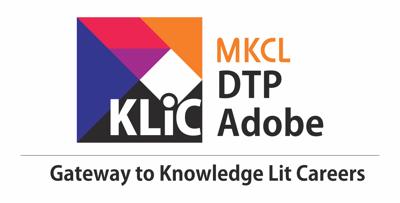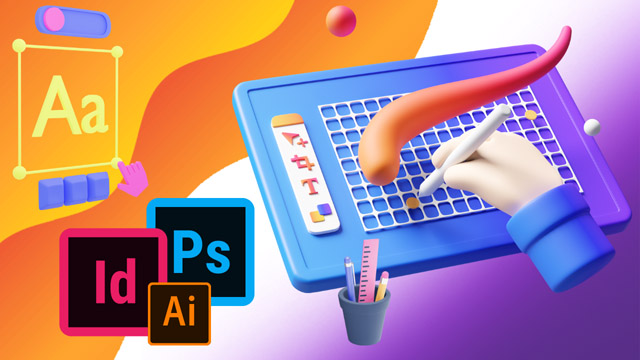- In this course, you will learn to:
- Identify key features and tools for document creation
- Organize workspace elements for efficient workflow management
- Create, edit, and manage documents
- Utilize advanced document management techniques such as threading text and managing pages
- Operate advanced features for layout design, including layers and master pages
- Modify and enhance text using formatting tools and effects
- Differentiate between various object types and apply appropriate transformations
- Distinguish between different drawing tools and techniques
- Estimate and apply color management techniques for document design
- Predict and implement table creation and styling
- Identify industry-standard practices and career opportunities in graphic design
- Explain the process and benefits of merging data
- Report on the importance and usage of templates for efficient design workflows

Adobe InDesign Mastery: Advanced Techniques for Creating Efficient Designs
Learn efficient layout design, typographic control, and document structuring using Adobe InDesign.
Introduction
What you'll learn ?
- At the end of this course, learners will be able to:
- Interpret and utilize key features and tools for document creation
- Organize workspace elements to enhance workflow efficiency
- Create, edit, and manage documents proficiently
- Utilize advanced document management techniques, such as threading text and managing pages
- Operate advanced features for layout design, including layers and master pages
- Modify and enhance text using formatting tools and effects
- Differentiate between various object types and apply appropriate transformations
- Distinguish between different drawing tools and techniques
- Estimate and apply color management techniques for document design
- Predict and implement table creation and styling
- List out industry-standard practices and career opportunities in graphic design
- Summarize the process and benefits of merging data
- Report on the importance and usage of templates for efficient design workflows
Syllabus
- Understanding Quick Preview
- Exploring the Workspace
- Using Toolbox
- Working with documents
- Working with panels
- Getting help while you work
- Creating a New Document
- Creating a New Document from a Template
- Creating New Document Using Presets
- Setting up a Document
- Using the Zoom and Hand tools
- Working with Rulers
- Using Smart Guides
- Using Grids
- Working with the Info Panel
- Creating and Displaying Workspaces
- Changing the Display View
- Using Undo and Redo
- Using the Pages Panel
- Inserting pages
- Navigating pages
- Deleting or Moving Pages
- Working with Page Spreads
- Creating Master pages
- Working with Master Pages
- Working with Page Number and Sections
- Working with Chapter Numbers
- Creating and Using Text Variables
- Creating a Book
- Managing Books
- Creating a Table of Contents
- Adjusting Layouts
- Using the Type tool
- Adding Text to Frame
- Threading text
- Editing text
- Using the Find/Change feature
- Working with Glyphs and Special Characters
- Using Spell-check and Language Dictionaries
- Formatting text
- Changing Fonts and Font Size
- Text Leading
- Kerning and tracking
- Formatting paragraphs
- Aligning text
- Tabs and indents
- Bullets and Numbering
- Text Composition
- Using Layers to improve efficiency
- Setting up Flyer
- Modifying and finishing the Flyer design
- Setting compound paths
- Colorizing images
- Controlling Graphics Display Performance
- Displaying XMP Graphics Information
- Creating a New Object
- Creating Lines
- Selecting objects
- Using Basic Strokes and Fills
- Using advanced strokes
- Using Transparency
- Adding Drop Shadows
- Applying Feathering
- Using Other Effects to Format Objects
- Using the Eyedropper tool
- Create Brochure, set up document
- Enhancing and completing the Brochure design
- Stacking objects
- Creating a New Layer
- Using Layers
- Nesting Objects
- Editing Frame and Path Shapes
- Understanding Corner Options
- Grouping and Locking Objects
- Aligning and Distributing
- Using Anchored Objects
- Transforming Objects
- Duplicating and Flipping Objects
- Working with Points and Paths
- Drawing with the Pen Tool
- Selecting and Moving Points and Segments
- Converting Points
- Adding and Deleting Anchor Points
- Splitting Paths
- Using the Smooth tool
- Using the Pencil Tool
- Working with Pathfinder
- Joining and Closing Anchor Points
- Reshape Paths
- Creating a Compound Path
- Creating a Book Cover
- Finalizing book cover design
- Working With Color Modes
- Applying Color
- Using the Eyedropper Tool
- Working with the Color Panel
- Working with Swatches
- Tints
- Applying Gradients
- Mixing Inks
- Using Colors from Imported Graphics
- Finalizing the documents
- Using Custom Dictionaries
- Finding and Changing Fonts
- Using Find and Change
- Searching for Text
- Searching using GREP
- Searching for Glyphs
- Searching for Objects
- Working with Hyphenation
- Keeping Lines together
- Changing Justification Options
- Changing Case
- Using the Story Editor
- Adding Footnotes
- Working with Notes
- Exporting a Document
- Understanding Export File Formats
- Exporting as PDF File
- Designing newspaper article
- Exporting as an EPS
- Exporting Cross-Media Files
- Exporting as a JPEG
- Printing a Document
- Printing Presets
- Setting General and Setup Print Options
- Setting Marks and Bleed Options
- Setting Graphics Options
- Previewing Color Separation
- Setting Output options
- Setting trapping options
- Setting Advanced Options
- Setting color management options
- Creating a print Summary
- Printing spreads in a booklet
- Using Live Preflight
- Inserting File Information
- Updates in Graphic Designing
- Required skills to design graphics
- Tools for designing
- Designing graphics rapidly
- Creating quirky designs
- Enhancing the document
- The SVG image support
- Recruitment and various job profiles
- Being careful and aware
- Requirements to begin a career
- Case Study-Entry Pass Design
- Using the shortcut keys for smart work
- Shortcuts and Conclusion
- Understanding the objective behind merging data
- Exploring benefits of data merging
- Listing requirements for merging data
- Merging data using data source file
- Using three tabs in merged document creation
- Merging data with MS Excel document
- Merging MS Word and PDF documents
- Comparing Print and Data Merge
- Learning the meaning and objectives
- Exploring asset handling capabilities
- Exploring tools for managing assets
- Understanding what templates are
- Creating visuals using templates
- Understand template use for specific goals
- Knowing appropriate templates for various mediums
- Identifying templates for various mediums
- Identifying software using templates for work
- Templates improve work efficiency
- Outcome
Certificate
- MKCL provides certificate (for 30/60/90 hours courses) to the KLiC learner after his/her successful course completion.
Academic Approach
The Academic Approach of the course focuses on the “work centric” education i.e. begin with work (and not from a book !), derive knowledge from work and apply that knowledge to make the work more wholesome, useful and delightful. The ultimate objective is to empower the Learner to engage in socially useful and productive work. It aims at leading the learner to his/her rewarding career as well as development of the society.
Learning methodology
- Learners are given an overview of the course and its connection to life and work.
- Learners are then exposed to the specific tool(s) used in the course through the various real-life applications of the tool(s).
- Learners are then acquainted with the careers and the hierarchy of roles they can perform at workplaces after attaining increasing levels of mastery over the tool(s).
- Learners are then acquainted with the architecture of the tool or Tool Map so as to appreciate various parts of the tool, their functions and their inter-relations.
- Learners are then exposed to simple application development methodology by using the tool at the beginner’s level
- Learners then perform the differential skills related to the use of the tool to improve the given ready-made outputs.
- Learners are then engaged in appreciation of real-life case studies developed by the experts.
- Learners are then encouraged to proceed from appreciation to imitation of the experts.
- After imitation experience, they are required to improve the expert’s outputs so that they proceed from mere imitation to emulation.
- Finally, they develop the integral skills involving optimal methods and best practices to produce useful outputs right from scratch, publish them in their ePortfolio and thereby proceed from emulation to self-expression.
Evaluation Pattern
Evaluation Pattern of KLiC Courses consists of 4 Sections as per below table:
| Section No. | Section Name | Total Marks | Minimum Passing Marks |
|---|---|---|---|
| 1 | Learning Progression | 25 | 10 |
| 2 | Internal Assessment | 25 | 10 |
| 3 | Final Online Examination | 50 | 20 |
| Total | 100 | 40 | |
| 4 | SUPWs (Socially Useful and Productive Work in form of Assignments) | 5 Assignments | 2 Assignments to be Completed & Uploaded |
MKCL’s KLiC Certificate will be provided to the learner who will satisfy the below criteria:
- Learners who have successfully completed above mentioned 3 Sections i.e. Section 1, Section 2 and Section 3
- Additionally, learner should have completed Section 4 (i.e. Section 4 will comprise of SUPWs i.e. Socially Useful and Productive Work in form of Assignments)
- Learner has to complete and upload minimum 2 out of 5 Assignments
Courses Fee Structure from 01 July, 2025 Onwards
KLiC 30 hour course fee applicable from 01 July, 2025 all over Maharashtra| KLiC Course Duration | MFO: MKCL Share (Including 18% GST) |
ALC Share (Service Charges to be collected by ALC) |
|---|---|---|
| 30 hours | Rs. 300/- | Rs. 1,500/- |
Important Points:
* Above mentioned fee is applicable for all Modes of KLiC Courses offered at Authorised Learning Center (ALC) and at Satellite Center
* Total fee is including of Course fees, Examination fees and Certification fees
* MKCL reserves the right to modify the Fee anytime without any prior notice
* Above mentioned fee is applicable for all Modes of KLiC Courses offered at Authorised Learning Center (ALC) and at Satellite Center
* Total fee is including of Course fees, Examination fees and Certification fees
* MKCL reserves the right to modify the Fee anytime without any prior notice
